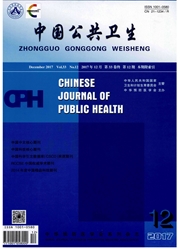

 中文摘要:
中文摘要:
目的了解农村已婚育龄妇女生殖道感染情况、最近一次出现生殖道感染症状后就诊情况及影响因素,为生殖健康干预提供依据。方法采用方便整群抽样方法,抽取安徽省3个县3个乡镇12个村中1398名已婚育龄妇女,运用自行设计的调查表进行入户面访调查。结果收集有效问卷1221份,70.43%的调查对象自我报告近1年中出现≥1种生殖道感染症状,42.67%出现白带增多症状;最近一次出现症状后就诊者占36.74%。52.53%的调查对象前去乡镇卫生院就诊,就诊后遵医嘱复查者占51.63%;70.77%未就诊者认为没必要就诊;42.59%和47.66%就诊者认为医生的水平较高、服务态度较好及很好。影响农村妇女就诊的因素有年龄、文化程度等。结论安徽省农村已婚育龄妇女生殖道感染症状发生率高,就诊率和遵医嘱复查率低。
 英文摘要:
英文摘要:
Objective To understand the prevalence of reproductive tract infections(RTls)and influence factors of the clinic-visiting status among rural married women at childbearing age in Anhui province. Methods Structured questionnaire was used and 1398 rural women at childbearing age selected by convenient duster sampling were surveyed by trained interviewers at respondents' households. Results A total of 1221 women were interviewed. The results showed that the percentage of women with self- reported symptoms of RTIs in past one year was 70.43 % and 36.74 % of the respondents with RTIs had sought health service. 52.53 % of the respondents with RTIs went to the countylevel hospital for health service. Of women seeking health care, 51.63 % were treated adequately. 70.77 % of the nonusers of health service thought it was unnecessary to consult a doctor, The rate of women who thought doctors with excdlent skills and good service attitude was 42,59 % and 47.66 %. The influence factors of clinic - visiting status include age and education. Conclusion The rate of self - reported symptoms of RTIs was high in the rural women of Anhui province, but the rate of seeking heath care and adequate treatment was low.
 同期刊论文项目
同期刊论文项目
 同项目期刊论文
同项目期刊论文
 期刊信息
期刊信息
